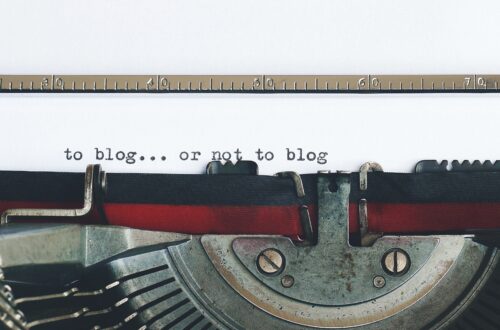On Writing Anti-Heroes Readers Love (and Hate)
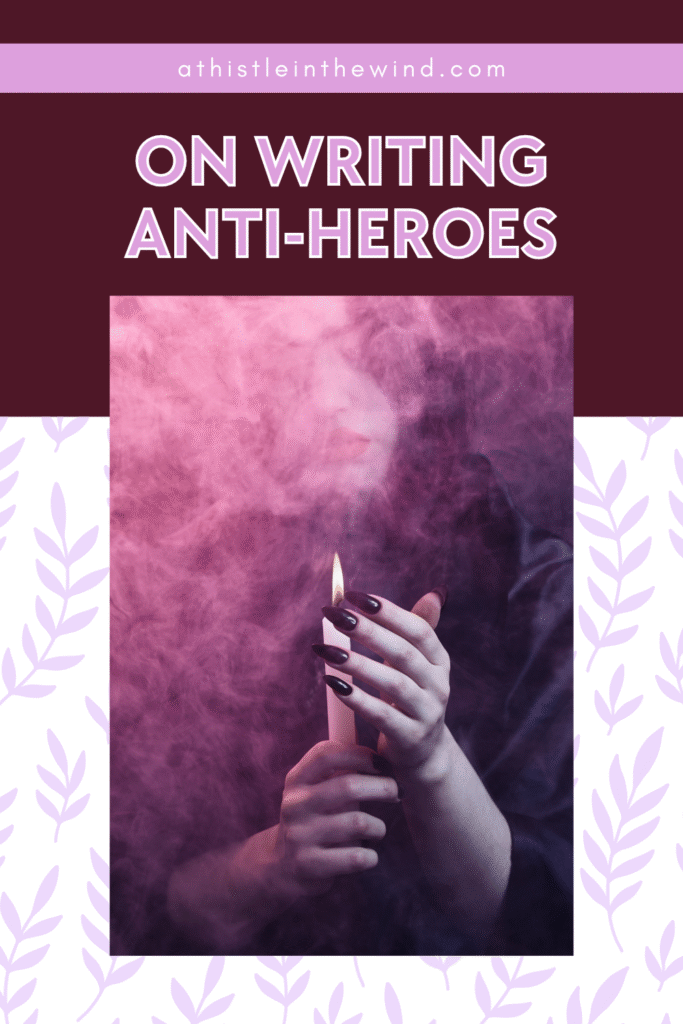
I don’t know about you, but I do love myself a nicely written anti-hero. Seriously. I spent my teens fangirling over Loki and Sherlock. Yes, I am that person. No, I didn’t end up developing a weirdly parasocial relationship with Tom Hiddleston or Benedict Cumberbatch.
I kind of grew out of it. But it did help me when I started dating in college. Of course, don’t tell that to my mother. As far as she’s concerned, I spent every waking hour pouring over my mechanical engineering coursework, and the only reason I didn’t pick up the phone that one week in May in 2019 is because I was studying for my finals and totally not attending this music festival two towns over.
We stay true to the canon, okay?
But enough about me: anti-heroes. Unless you’ve been living under a rock, you might’ve noticed an abundance of anti-heroes in fiction today. Seriously, they’re everywhere: books, TV shows, movies, and even in those weird role-playing TikToks.
Which begs the question: why?
And that’s exactly what we’re doing today. If you’re struggling to write a memorable anti-hero, welcome! In this blog, I’ll break down why anti-heroes resonate, what sets them apart from villains, and how you can write your own unforgettable morally grey protagonist. So, let’s begin.
The Anatomy of an Anti-Hero
Here’s a little exercise for you: think about your favourite historical figure. And if like me, you don’t care much about those, think about your favourite scientist. Mine’s Albert Einstein, who sure, can be considered a historical figure, but that’s not the point.
The point is: think about them, and then think about their virtues—what made them so likable. With Einstein, it’s simple: his academic achievements were phenomenal, and there are countless anecdotes about how approachable, good-natured, and endlessly curious he was.
But Einstein had a flaw: he was a bit of a womaniser, and yeah, it’s so easy to dismiss that. Yet, when I was sixteen, and I learned that my hero’s first wife, Mileva Marić, actually helped with the math behind relativity, and also about how he treated her.
Yeah, that rubbed me the wrong way. It still does. Because I could—as a woman—relate to Mileva more. And sure, you could argue that it was a doomed relationship from the start, and Mileva and Einstein were both too young to know any better. But the point stands: my hero treated his first wife badly. Even if that’s the last thing he wanted to do when they first met.
And sure, Einstein’s virtues are far greater than this one flaw. But it still stands. And depending on the kind of person you are, you might be able to ignore it—or you might not.
And this is exactly why people love anti-heroes: You can’t always be the good guy in everyone’s story.
Of course, it would be a gross overstatement to call Einstein an anti-hero. I certainly don’t think he is. But if you were looking at Einstein from Mileva’s perspective, you’re probably looking at an anti-hero.
It’s a matter of perspective—and in fiction, perspective is everything.
What is an Anti-Hero?
According to Britannica, an anti-hero is “a main character in a book, play, movie, etc., who does not have the usual good qualities that are expected in a hero.”
And yeah, that’s correct. Anti-heroes are definitely not the dashing, noble, or morally upright hero archetypes of old. Instead, they are often characterised by a complex moral compass that allows them to traverse ethical boundaries that a traditional hero would never cross.
Think of them as characters who are too flawed to be considered pure heroes. But they also possess enough redeeming qualities—or sympathetic motivations—to keep them from becoming outright villains.
There are too many writers (Darcey Bell) who seem to think that just because a suburban mom likes true crime and ‘accidentally’ caught the wrong guy, they’re anti-heroes.
They’re not; they’re textbook Karen and they’re annoying, and they’re everything wrong with writers these days.
But before I go off on this tangent, let’s reiterate once more before we move on:
Anti-heroes offer a bit of a duality: they’re not good enough, but they’re not bad enough either. And ultimately, it’s up to the reader to decide exactly why they’re supporting—or opposing—them.
Examples of Anti-Heroes
- In Fiction: Sandor Clegane from Game of Thrones is brutal, foul-mouthed, and more than a little unhinged. But under all that, he has his own twisted sense of honor—and he ends up protecting people he once claimed to despise.
- In Television: Walter White from Breaking Bad starts out as a desperate man trying to provide for his family but eventually becomes a ruthless criminal. He’s the textbook example of an anti-hero who slowly loses his moral compass.
- In Comics and Film: Loki from the Marvel Comics and the MCU is arrogant, selfish, and constantly plotting something, but he’s also painfully insecure and deeply human. That mix of villainy and vulnerability is what makes him so compelling.
How Anti-Heroes Differ from Traditional Heroes
As I’ve already established by now, anti-heroes are different from your stereotypical (think Thor or Superman) heroes. While we’ve already talked a bit about it, let’s take a closer look.
The contrast between an anti-hero and a classic hero highlights the anti-hero’s unique appeal:
- Moral Flexibility: A traditional hero operates within established systems and upholds societal norms. An anti-hero, however, often rejects authority and conventional morality, choosing their own path, even if it means ruffling feathers or breaking laws.
- Motivation: While traditional heroes are typically altruistic (guess who was on 80,000 Hours this week—lol), anti-heroes are often…self-interested, prioritising their own desires, security, or revenge.
- Tactics: Heroes employ noble means to achieve their goals. Anti-heroes, however, will resort to shady tactics, violence, deception—whatever it takes to get results.
- Personality: While heroes are kind, patient, and humble, anti-heroes often embody traits like rudeness, sarcasm, cynicism, and an antisocial streak. Weirdly enough, this makes them incredibly fun to write—and to read about.
This contrast is exactly what keeps readers hooked: an anti-hero feels unpredictable, messy, and painfully human.
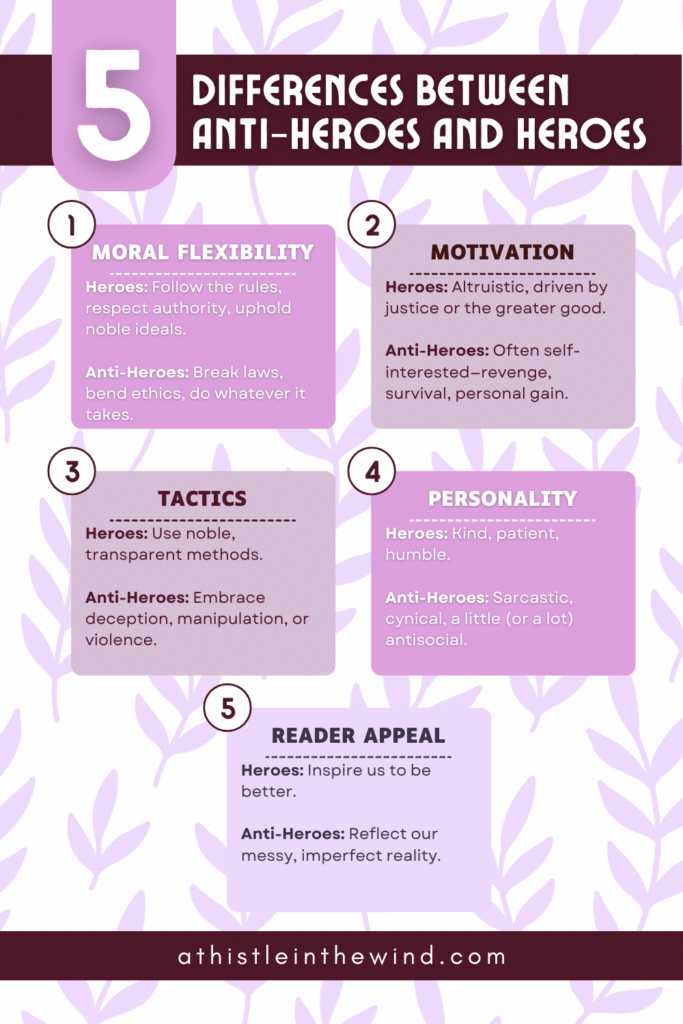
Why Readers Are Drawn to Anti-Heroes
Looking back at my Einstein example, if we ignore Mileva completely (and history has done a great job of that), Einstein’s a great guy. I really do believe he is. I mean, unlike a certain British children’s writer and her flaws, I’m willing to overlook Einstein’s—because there’s just so much more he did with his life.
And Einstein’s treatment of Mileva confirms two things: A) you should never meet your heroes, and B) even the greatest minds are unquestionably human.
And that’s what modern audiences want. There’s so much happening in the world right now and we all know it’s impossible for people to just be…good. So when we turn to fiction—no matter the medium—we want characters who mirror the complexities of real life.
And this has led to the rise of the anti-hero.
At their core, these types of characters are a more human approach to heroism, reflecting the messy realities of life rather than presenting an unattainable ideal.
So, when you write them, readers will connect with their flaws, their struggles, and the internal battles they face, seeing a reflection of their own imperfect attempts to navigate a complex world.
This relatability, coupled with their inherent unpredictability, creates a captivating dynamic. After all, haven’t you ever done anything that might be considered wrong? Like, lying to your parents about music festivals? Or missing work and coming up with some private medical emergency excuse? We’ve all done it, but in our case, that doesn’t mean anything.
For anti-heroes, this keeps the audience on edge, constantly wondering what they’ll do next. They embody a sense of rebellion, speaking out against convention and defying expectations. This ongoing tension between their overall goal and the methods they employ is a powerful source of compelling conflict, keeping the reader invested and engaged in their journey.
The Anti-Hero’s Journey
The narrative arc of an anti-hero is rarely a neat progression from bad to good. More often, it’s a messy, fascinating deep dive into their internal battles and the questionable choices they make along the way. Think about Walter White spiraling into moral oblivion, or Loki oscillating between saving the world and trying to rule it.
These characters usually set out on a mission only to discover that their methods for getting what they want are fundamentally flawed. Their path is littered with contradictions, impulsive decisions, and the constant tug-of-war between their better instincts and their worst impulses.
A common thread in anti-hero stories is the potential for growth—or complete collapse. Sometimes, they claw their way toward a semblance of redemption, letting go of the one trait that was holding them back and proving that maybe, just maybe, there’s something good under all the chaos. Other times, they double down on their worst instincts and end up destroying themselves. That’s the beauty (and the heartbreak) of writing anti-heroes: you never really know which way they’re going to fall until the very end.
Exploring Anti-Hero Archetypes
So, naturally, with anti-heroes, we don’t have a one-size-fits-all situation. Writers have a dozen approaches when they create these incredibly complex protagonists. Understanding these archetypes can help you tailor your anti-hero to best serve your story’s themes and conflicts.
1. The Classical Anti-Hero
Contrasting with the confident, nearly flawless traditional hero, this type is plagued by self-doubt and a pervasive lack of confidence. They’re the “everyman” figures, unassuming and often reluctant, thrust into heroism against their nature. Think Frodo Baggins from The Hobbit—he’s burdened, exhausted, and frequently tempted by the Ring’s power.
2. The Corrupt Protagonist
This anti-hero is driven by self-interest—power, wealth, revenge. Their story usually starts off normal, but a catalyst (like a terminal diagnosis) pushes them into darker territory. Walter White from Breaking Bad is the classic example of this spiral into moral decay.
3. The Pragmatic Anti-Hero
These characters see the “big picture” above all else. They’re willing to make terrible sacrifices because they genuinely believe the ends justify the means. Tywin Lannister from Game of Thrones fits here perfectly—ruthless, calculating, convinced he’s the only one who can hold everything together.
4. The Unscrupulous Anti-Hero
This morally complex protagonist makes toxic and damaging choices to achieve their goals. They are often single-minded, driven to obsession, and prone to losing sight of ethical boundaries they once possessed. Thomas Shelby from Peaky Blinders is a great example: you can almost root for him—until you can’t.
5. The Hero In Name Only
These characters walk a precarious tightrope between hero and villain. They are fundamentally on the side of good, but their methods or underlying nature prevent them from being “purely good.” Homelander from The Boys is the perfect example for this—publicly adored, privately terrifying.
6. The Sympathetic Anti-Hero
These anti-heroes have a compelling reason for their standoffishness or morally grey behaviour. They’ll often have a tragic backstory, often involving abuse or harm inflicted by society, making their difficult exterior understandable. Jessica Jones from Jessica Jones is a good example: prickly, jaded, but undeniably sympathetic because of her past.
7. The Self-Interested Anti-Hero
Often portrayed as sarcastic rogues, these anti-heroes possess a biting wit and a disregard for politeness. Their primary concern is protecting their own interests, sometimes at the expense of others. Think Jack Sparrow from Pirates of the Caribbean. He’s absolutely self-interested, sarcastic, and mostly out for himself, but he does have occasional moral lines.
8. The Unwilling Anti-Hero
This character simply wants to be left alone and is dragged into the story against their will. Their journey is characterised by their attempts to escape their new obligations and return to their former life, often complaining vociferously along the way. Geralt of Rivia from The Witcher spends half his time just trying to mind his business—and failing spectacularly.
9. The Vigilant Anti-Hero
A common figure in crime and thriller genres, the vigilant anti-hero is a “lone wolf” who rejects official authority and societal notions of justice. Driven by their own (often skewed) moral code, they set out to correct perceived evils, frequently employing violence, deception, and other illicit means. The Punisher from the Marvel Comics is a great example of this. He operates outside the law, using violence to avenge his family.
10. The Trickster Anti-Hero
Rooted in folklore and myth, tricksters are clever, self-interested, and impossible to pin down. They often compensate for physical disadvantages with cunning and wit. These characters are known for changing sides mid-narrative but they typically align with the side of good by the story’s conclusion. Honestly, Loki from Norse Mythology is the blueprint for this—always scheming, always entertaining.
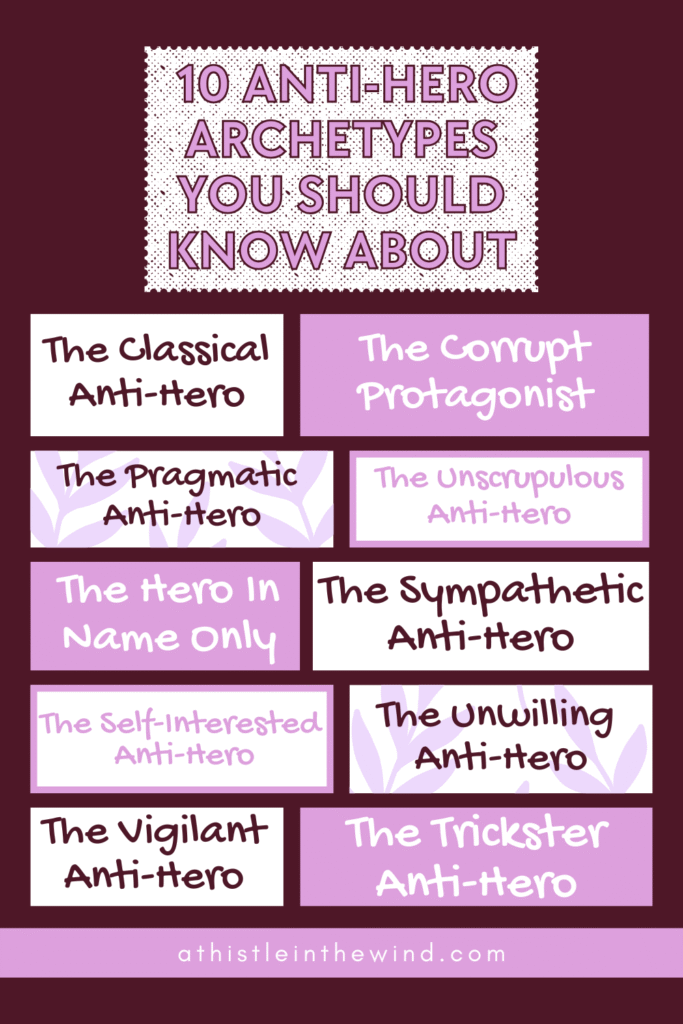
How to Write An Anti-Hero: Tips to Get You Started
Now that you’re up to speed with what anti-heroes are, the next step, naturally, is figuring out how to make them good. And by good, I mean writing an anti-hero who resonates deeply with readers and doesn’t just feel like another edgy stereotype. To do that, you need to infuse them with real, human struggles and motivations.
This goes way beyond giving them a snarky attitude or a tragic haircut. It requires understanding their inner world—what they want, what they fear, and why they believe the things they do.
Now that you’re up to speed with what anti-heroes are, the next step, naturally, is figuring out how to make them good. And by good, I mean writing an anti-hero who resonates deeply with readers and doesn’t just feel like another edgy stereotype. To do that, you need to infuse them with real, human struggles and motivations.
This goes way beyond giving them a snarky attitude or a tragic haircut. It requires understanding their inner world—what they want, what they fear, and why they believe the things they do.
1. Give Them a Purposeful Flaw
Every compelling anti-hero is defined by a significant flaw or a deeply held, harmful belief that constantly gets in their way. This isn’t just a quirky trait or a random bad habit—it’s a core internal struggle that shapes their choices. Maybe they’re convinced they’re fundamentally unworthy of love, or that trusting anyone will always end in betrayal.
This flaw is often the reason they resort to questionable methods, because in their mind, it’s the only way to survive. By giving them something profound to wrestle with, you lay the groundwork for a powerful arc that feels honest and satisfying.
2. The Power of Backstory
An anti-hero’s abrasive behavior or morally dubious choices shouldn’t come out of nowhere. A well-developed backstory gives context, explaining why they are the way they are. Maybe they grew up in a violent household, or watched someone they loved get torn apart by a system they were supposed to trust. Even if you never spell out every detail to your audience, knowing your character’s past helps you write them with conviction.
Their decisions and reactions feel authentic, and readers can trace the line between what happened to them and who they’ve become. That depth is what keeps them from feeling like a flat caricature who’s just “bad for bad’s sake.”
3. A Unique Moral Code
Even the most ruthless anti-hero operates by some internal rules. It might not look like a traditional moral compass, but it’s there. Maybe they never harm children or animals. Maybe they always keep their word, no matter what. This consistent (if unconventional) code helps the reader understand their boundaries.
It also makes them predictable in their unpredictability—no matter how wild their actions get, you know there are lines they won’t cross. That tension is part of what makes them compelling.
4. Understanding Over Approval
One of the trickiest balances to strike is making sure your audience understands your anti-hero, even if they don’t agree with them. Readers can tolerate a surprising amount of shady behavior if they grasp the underlying motivations. This understanding usually comes from a solid backstory that reveals the pain or desperation behind their choices.
When you let readers see their internal world—the fear, the anger, the fragile hope—you build a bridge that transcends moral judgment. Even if your anti-hero does something awful, that empathy keeps readers invested.
5. The Principle vs. Context Dilemma
Consider exactly who your anti-hero is harming and why. Audiences are much more forgiving when characters break abstract rules or target faceless institutions—like corrupt governments or massive corporations. That’s why we all love a good “steal from the rich” story. But the second your anti-hero starts hurting specific, sympathetic individuals, you risk losing reader support.
If your protagonist robs a bank, most people will root for them. If they rob a single mom’s rent money, not so much. Be mindful of this dynamic. You can let them push against social norms and defy expectations, but if they cross too many personal lines, they’ll start to feel less like an anti-hero and more like a villain in disguise.
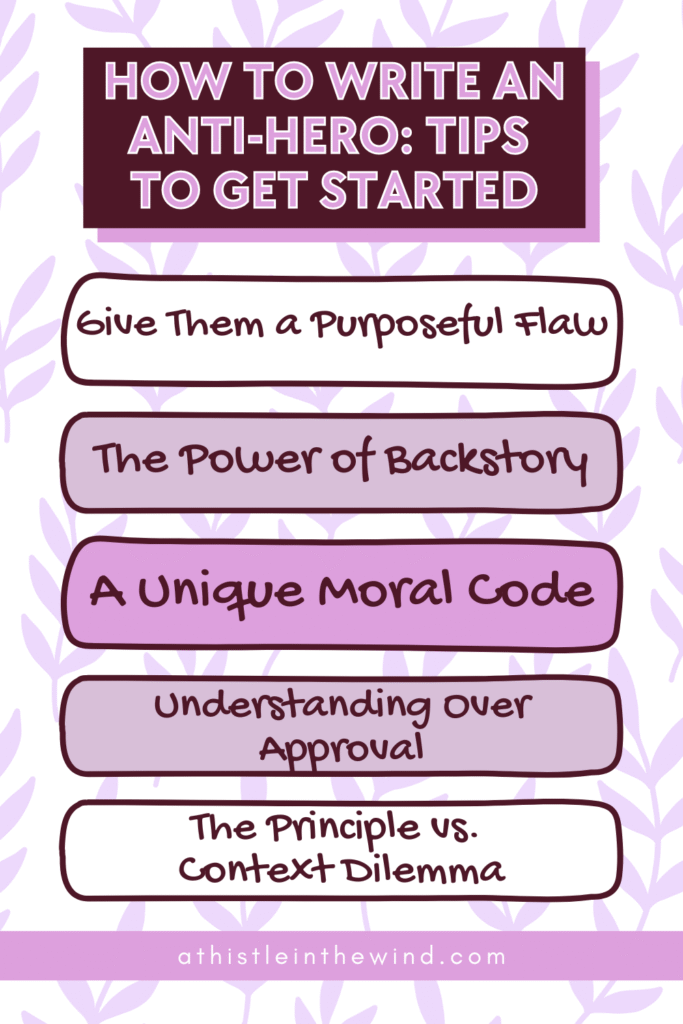
Exploring Your Anti-Hero’s Arc
An anti-hero’s journey is rarely static. They’re characters built for transformation—sometimes in the best way, sometimes in the most spectacularly awful way. The type of arc you choose will shape your story’s themes and how your readers ultimately feel about everything you’ve put them through.
- Positive Arcs: In a positive arc, the anti-hero gradually moves away from their darker traits and grows into a more heroic version of themselves. This doesn’t mean they become squeaky clean, but they learn to confront their flaws, adopt better methods, or find a purpose beyond self-interest. Often, it takes other characters to act as catalysts—think of Jaime Lannister, from Game of Thrones, who gradually grows past his arrogance—mostly thanks to Brienne’s influence. Positive arcs show that even the most stubborn cynics can surprise us.
- Flat Arcs: Sometimes the anti-hero doesn’t really change at all. Instead, they stay firmly rooted in their worldview, and it’s everyone else who has to react to them. They might represent the path another character fears or the lie someone believes. Geralt of Rivia, from The Witcher, stays consistent—cynical, principled on his own terms—and forces others to question their assumptions.
- Negative Arcs: The most tragic path, negative arcs show the anti-hero slipping deeper into corruption until they lose what little goodness they had left. These stories often start with relatable motives—a desire to protect or fix something—and end with the character becoming the very thing they once fought against. Walter White is the ultimate cautionary tale: you see every choice that leads to his downfall, and you still can’t look away. Michael Corleone in The Godfather is another—he starts out trying to protect his family and ends up destroying everything he loves.
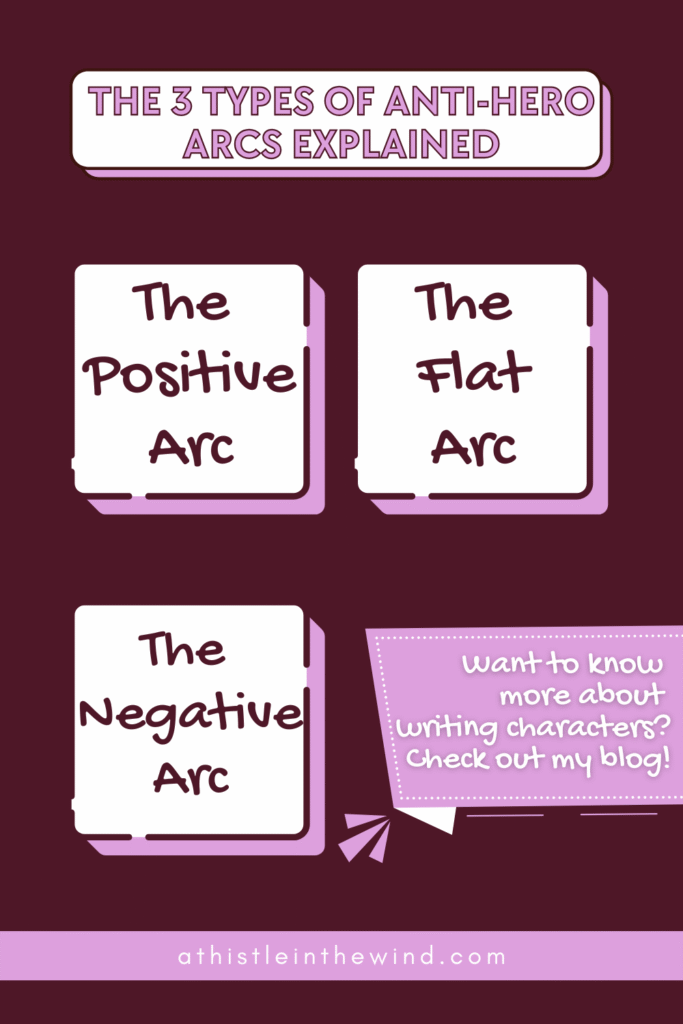
Don’t Forget to Humanise Your Characters Beyond the Anti-Heroism
So, yeah, that’s it: everything you need to know about anti-heroes. Remember, to keep your anti-hero from turning into a one-note “edgy” cliché, show the sides of them that have nothing to do with their questionable decisions.
Let them have a hobby, an unexpected softness, or some bizarre little quirk they’d die if anyone found out about. Maybe they bake bread at 3 a.m. to cope, or they watch terrible reality TV with alarming dedication.
Anyway, that’s my two cents on this. So, now it’s your job to go and write your brooding, complicated anti-heroes—make them layered, messy, and impossible to forget.
Those glimpses of vulnerability remind us they’re more than just their worst choices. And honestly, it makes the darker moments hit way harder.
And if you’re still in the mood for unsolicited advice, I’ve got a bunch of blogs related to writing. Check em out:
